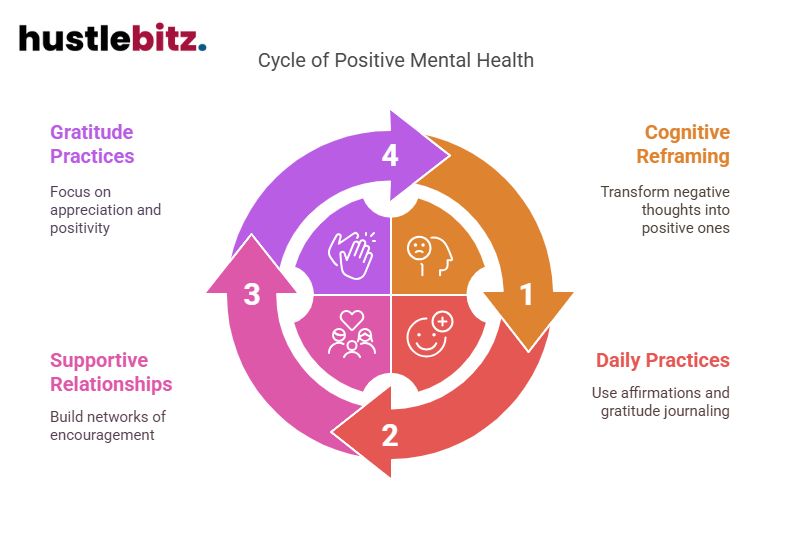Beyond the shadows, embracing light through positive thinking transforms challenges into opportunities for growth. This optimistic mindset fosters resilience, reduces anxiety, and enhances overall emotional well-being. Techniques such as cognitive reframing, mindfulness, and gratitude practices counteract negative thought patterns, promoting a healthier outlook on life. Daily affirmations and surrounding oneself with supportive communities further strengthen this positivity. Together, these strategies create an enriching environment that nurtures relationships, builds emotional strength, and fosters personal fulfillment. Exploring these concepts can lead to a deeper understanding of how positivity shapes our lives and illuminates paths forward.
Key Takeaways
- Positive thinking serves as a guiding light, fostering resilience and helping individuals navigate through life’s challenges more effectively.
- Cognitive reframing transforms negative thoughts into constructive alternatives, promoting a more hopeful and positive mindset.
- Daily practices like affirmations and gratitude journaling can reshape thoughts, enhancing self-belief and appreciation for life’s positives.
- Building supportive relationships creates networks of encouragement, offering emotional strength and enhancing overall outlook during difficult times.
- Engaging in gratitude practices shifts focus from negativity to appreciation, enriching experiences and promoting lasting mental and emotional well-being.

The Light Positive Thinking Brings

Positive thinking serves as a beacon of hope, illuminating the path through challenges and fostering resilience in the face of adversity. This mindset transformation is not merely an abstract concept but a practical approach that channels light energy into everyday life. By consciously choosing to focus on the positive aspects of situations, individuals can cultivate a sense of emotional resilience that empowers them to navigate difficulties more effectively.
One of the foundational practices that complements positive thinking is gratitude. Engaging in a gratitude practice allows individuals to recognize and appreciate the small joys and victories in their lives, further enhancing their outlook. This simple yet powerful exercise can transform daily experiences into sources of inspiration and motivation. By acknowledging what one is grateful for, it becomes easier to shift perspective and embrace positivity.
Moreover, the integration of daily inspiration through affirmations or uplifting literature can reinforce the benefits of positive thinking. These practices serve as reminders of the potential for growth and positivity, helping to create an environment where light energy can flourish.
In essence, the light that positive thinking brings is multifaceted, encompassing a profound ability to reshape one’s mindset, enhance emotional resilience, and cultivate a fulfilling life. By embracing this approach, individuals not only improve their personal outlook but also contribute to a more optimistic and supportive community.
Ultimately, the journey toward positivity is a continuous endeavor, one that equips individuals with the tools to thrive amidst life’s uncertainties.
Benefits of an Optimistic Mindset
An optimistic mindset not only enhances emotional resilience but also unlocks a myriad of benefits that can significantly improve overall well-being and life satisfaction. By fostering a positive outlook, individuals can engage in resilience building, which equips them to better navigate life’s challenges. This adaptability is crucial for mental health, as it reduces the likelihood of developing anxiety and depression.
Moreover, an optimistic perspective contributes to stress reduction. Optimists are more likely to approach stressful situations with a solution-focused mindset, allowing them to manage stress more effectively. This proactive approach can lead to healthier coping strategies, reducing the physiological impact of stress on the body.
Additionally, cultivating an optimistic mindset enhances emotional intelligence. Individuals who maintain a positive outlook are often more aware of their emotions and those of others, facilitating improved interpersonal relationships. This heightened emotional awareness not only enriches personal interactions but also boosts collaborative efforts in professional settings.
Goal setting is another area where an optimistic mindset proves beneficial. Optimists are inclined to set ambitious yet attainable goals, believing in their capacity to achieve them. This belief fuels motivation and persistence, essential components for success. As they work toward their objectives, the positive reinforcement gained from small achievements further strengthens their optimistic outlook.
Overcoming Negative Thought Patterns

Overcoming negative thought patterns is essential for fostering a healthier mindset and enhancing overall emotional well-being. Negative thoughts can often spiral, leading to feelings of inadequacy, anxiety, and depression. To combat these detrimental patterns, individuals can employ various strategies that promote a more positive outlook.
Cognitive reframing techniques allow individuals to challenge and alter their negative thoughts by replacing them with more constructive alternatives. This practice encourages a shift in perspective, making it easier to see situations in a more balanced light.
Complementing this approach, mindfulness practices help individuals stay present, reducing the tendency to ruminate on past failures or future anxieties.
Incorporating self-compassion exercises is equally vital, as they promote kindness toward oneself during moments of struggle. Acknowledging that everyone experiences difficulties can foster resilience and alleviate harsh self-judgments.
Additionally, gratitude journaling serves as a powerful tool for recognizing and appreciating the positive aspects of life, effectively countering feelings of negativity.
Visualization strategies can further enhance this process by allowing individuals to vividly imagine positive outcomes and experiences, thereby reinforcing a hopeful mindset.
Defeating the Shadows With Positivity

Harnessing the power of positivity can effectively illuminate the shadows cast by negative thought patterns, fostering a more resilient and optimistic mindset. To combat these shadows, individuals can adopt specific positivity practices that encourage mental clarity and emotional empowerment.
By consciously shifting focus to positive experiences and affirmations, one can begin to dismantle deeply rooted negative beliefs, thereby enhancing shadow resilience.
One effective technique is light visualization, where individuals envision a warm, radiant light enveloping them, symbolizing hope and positivity. This practice not only serves as a mental refuge but also reinforces the belief in one’s ability to overcome challenges. As the mind visualizes light, it begins to associate feelings of safety and empowerment, effectively diminishing the grip of negativity.
Furthermore, establishing a routine of positivity practices—such as gratitude journaling, mindfulness meditation, or engaging in uplifting conversations—can serve as a powerful antidote to negative thought cycles. These practices not only foster emotional empowerment but also promote a sustained sense of mental clarity, enabling individuals to approach challenges with a renewed perspective.
Affirmations for Daily Uplifting

Daily affirmations serve as a powerful tool for cultivating a positive mindset, enabling individuals to reinforce self-belief and foster emotional resilience. By consciously repeating positive statements, individuals can reshape their thoughts and beliefs, paving the way for a more optimistic outlook on life. Incorporating daily affirmations into one’s routine enhances self-love practices, encouraging a deeper acceptance of oneself and reducing negative self-talk.
To maximize the impact of daily affirmations, individuals may integrate them with gratitude journaling. This practice not only allows for reflection on positive experiences but also creates a foundation of appreciation that complements affirmations. By acknowledging what one is grateful for, the affirmations resonate more deeply, fostering a sense of abundance rather than scarcity.
Moreover, visualization techniques can further amplify the effectiveness of affirmations. By visualizing oneself embodying the qualities expressed in the affirmations, individuals engage their imagination to manifest their desired realities. This mental imagery complements the affirmations, making the positive changes feel more attainable.
Mindfulness exercises also play a critical role in the affirmation process. By cultivating present-moment awareness, individuals can better recognize and replace negative thoughts with affirmations. This practice not only enhances emotional well-being but also solidifies the positive messages being reinforced through daily affirmations.
Incorporating these strategies creates a holistic approach to personal development, leading to sustained emotional upliftment and a more positive daily experience.
Surrounding Yourself With Positivity
Creating a positive environment is fundamental to reinforcing the benefits of daily affirmations and enhancing overall well-being. Surrounding oneself with positivity involves intentionally cultivating spaces where uplifting relationships thrive, allowing individuals to flourish emotionally and mentally. Such positive environments foster connections that uplift, support, and inspire personal growth.
Establishing uplifting relationships is essential for creating a network of encouragement. Engaging with individuals who share similar values and aspirations can significantly enhance one’s outlook on life. These relationships, characterized by mutual respect and understanding, provide a foundation for resilience in the face of challenges.
In addition to nurturing relationships, integrating gratitude practices into daily routines can amplify positivity. By regularly reflecting on and acknowledging the good in life, individuals can shift their focus from negativity to appreciation, reinforcing a mindset of abundance. This practice not only enriches personal experiences but also positively influences interactions with others.
Moreover, being part of supportive communities can provide invaluable resources for emotional support. These communities, whether online or offline, create spaces where individuals can share experiences and find encouragement in one another’s journeys. Mindful interactions within these groups promote empathy and understanding, further solidifying the bonds that contribute to a positive environment.
Final Thoughts
Embracing positive thinking and surrounding yourself with a supportive, uplifting environment is key to personal growth and emotional resilience. By integrating practices like affirmations, gratitude, and mindfulness, you can reshape negative thought patterns and cultivate a healthier mindset. Building strong, positive relationships and maintaining a focus on gratitude enriches not only your personal experiences but also your interactions with others. Ultimately, with consistent effort and a focus on positivity, you can illuminate the path forward, turning challenges into opportunities for growth and fulfillment.




